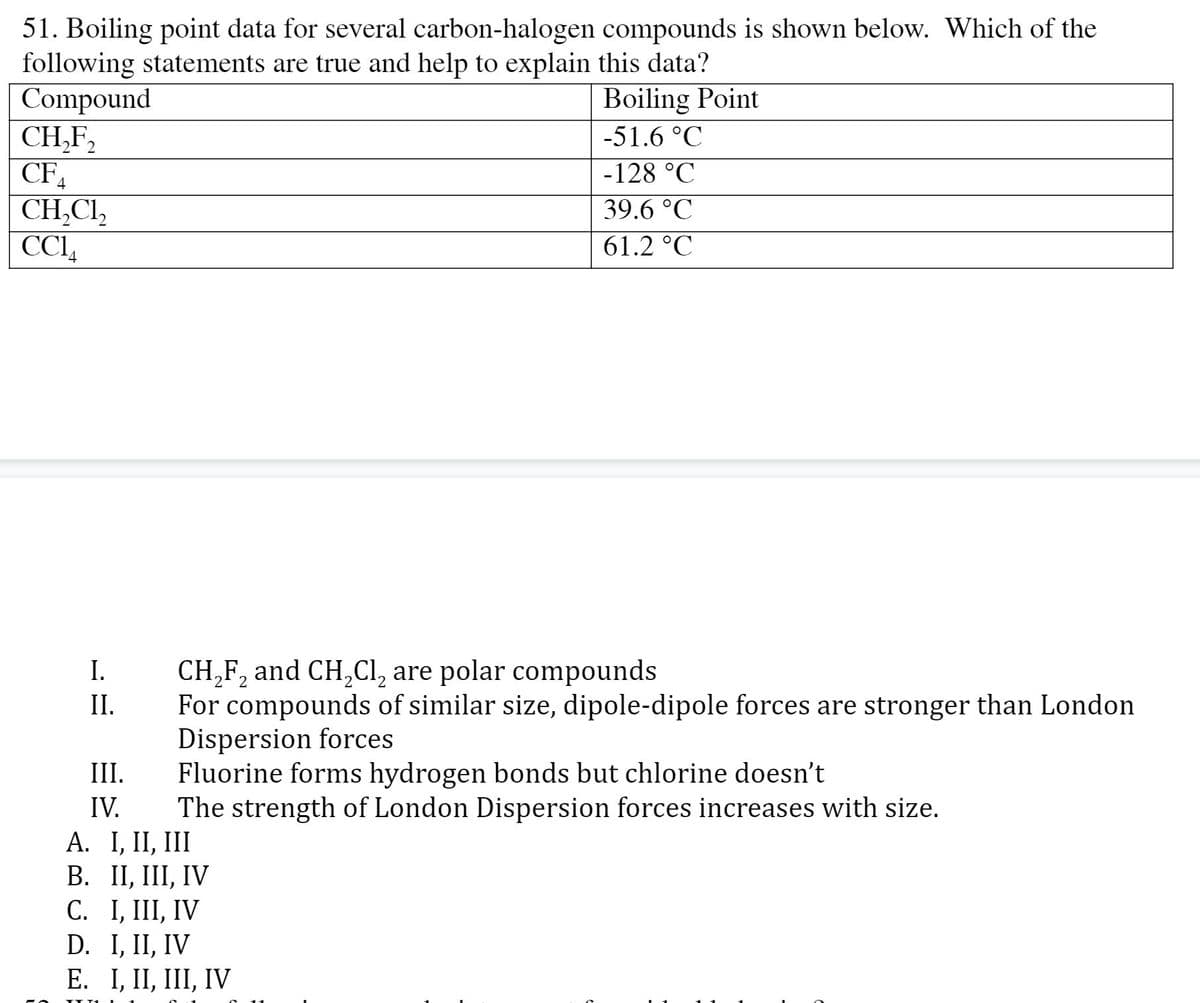51. Boiling point data for several carbon-halogen compounds is shown below. Which of the following statements are true and help to explain this data? Compound CH,F, CF, CH,CI, CCI, Boiling Point -51.6 °C -128 °C 39.6 °C 61.2 °C CH,F, and CH,Cl, are polar compounds For compounds of similar size, dipole-dipole forces are stronger than London Dispersion forces Fluorine forms hydrogen bonds but chlorine doesn't The strength of London Dispersion forces increases with size. I. II. III. IV. А. I, I, I В. П, Ш, IV С. I, I, IV D. I, II, IV LIL II IY
51. Boiling point data for several carbon-halogen compounds is shown below. Which of the following statements are true and help to explain this data? Compound CH,F, CF, CH,CI, CCI, Boiling Point -51.6 °C -128 °C 39.6 °C 61.2 °C CH,F, and CH,Cl, are polar compounds For compounds of similar size, dipole-dipole forces are stronger than London Dispersion forces Fluorine forms hydrogen bonds but chlorine doesn't The strength of London Dispersion forces increases with size. I. II. III. IV. А. I, I, I В. П, Ш, IV С. I, I, IV D. I, II, IV LIL II IY
Chemistry & Chemical Reactivity
9th Edition
ISBN:9781133949640
Author:John C. Kotz, Paul M. Treichel, John Townsend, David Treichel
Publisher:John C. Kotz, Paul M. Treichel, John Townsend, David Treichel
Chapter11: Intermolecular Forces And Liquids
Section: Chapter Questions
Problem 51SCQ
Related questions
Concept explainers
Bond Parameters
Many factors decide the covalent bonding between atoms. Some of the bond parameters are bond angle, bond order, enthalpy, bond length, etc. These parameters decide what kind of bond will form in atoms. Hence it is crucial to understand these parameters in detail and understand how changing these parameters affects the kind of bonding or various characteristics.
Bond Dissociation Energy
The tendency of an atom to attract an electron is known as its electronegativity.
Question
Question is in the picture

Transcribed Image Text:51. Boiling point data for several carbon-halogen compounds is shown below. Which of the
following statements are true and help to explain this data?
Compound
CH,F,
Boiling Point
-51.6 °C
-128 °C
CH,CI,
CCI,
39.6 °C
61.2 °C
CH,F, and CH,Cl, are polar compounds
For compounds of similar size, dipole-dipole forces are stronger than London
Dispersion forces
Fluorine forms hydrogen bonds but chlorine doesn't
The strength of London Dispersion forces increases with size.
I.
II.
III.
IV.
A. I, II, III
В. П, 1, IV
С. 1, II, IV
D. I, II, IV
Е. I, II, II, IV
Expert Solution
This question has been solved!
Explore an expertly crafted, step-by-step solution for a thorough understanding of key concepts.
Step by step
Solved in 2 steps

Knowledge Booster
Learn more about
Need a deep-dive on the concept behind this application? Look no further. Learn more about this topic, chemistry and related others by exploring similar questions and additional content below.Recommended textbooks for you

Chemistry & Chemical Reactivity
Chemistry
ISBN:
9781133949640
Author:
John C. Kotz, Paul M. Treichel, John Townsend, David Treichel
Publisher:
Cengage Learning

Chemistry & Chemical Reactivity
Chemistry
ISBN:
9781337399074
Author:
John C. Kotz, Paul M. Treichel, John Townsend, David Treichel
Publisher:
Cengage Learning

Introductory Chemistry: A Foundation
Chemistry
ISBN:
9781337399425
Author:
Steven S. Zumdahl, Donald J. DeCoste
Publisher:
Cengage Learning

Chemistry & Chemical Reactivity
Chemistry
ISBN:
9781133949640
Author:
John C. Kotz, Paul M. Treichel, John Townsend, David Treichel
Publisher:
Cengage Learning

Chemistry & Chemical Reactivity
Chemistry
ISBN:
9781337399074
Author:
John C. Kotz, Paul M. Treichel, John Townsend, David Treichel
Publisher:
Cengage Learning

Introductory Chemistry: A Foundation
Chemistry
ISBN:
9781337399425
Author:
Steven S. Zumdahl, Donald J. DeCoste
Publisher:
Cengage Learning

Chemistry for Engineering Students
Chemistry
ISBN:
9781337398909
Author:
Lawrence S. Brown, Tom Holme
Publisher:
Cengage Learning

General Chemistry - Standalone book (MindTap Cour…
Chemistry
ISBN:
9781305580343
Author:
Steven D. Gammon, Ebbing, Darrell Ebbing, Steven D., Darrell; Gammon, Darrell Ebbing; Steven D. Gammon, Darrell D.; Gammon, Ebbing; Steven D. Gammon; Darrell
Publisher:
Cengage Learning

Chemistry for Engineering Students
Chemistry
ISBN:
9781285199023
Author:
Lawrence S. Brown, Tom Holme
Publisher:
Cengage Learning